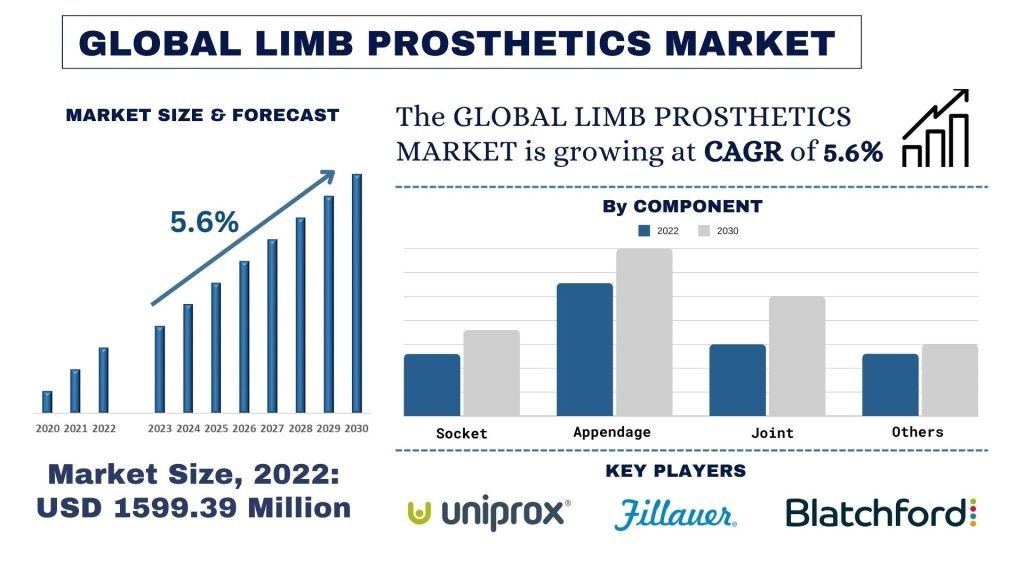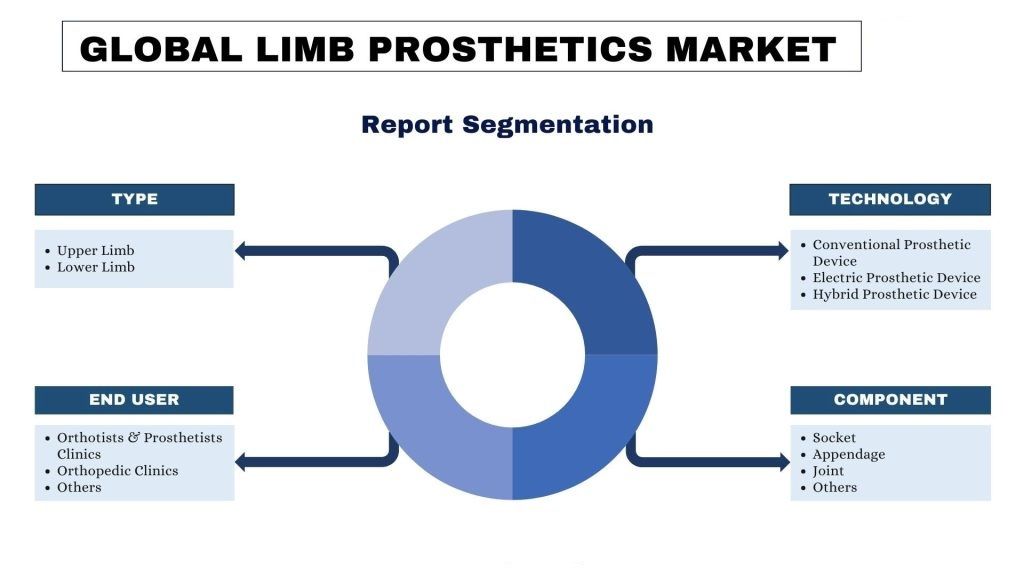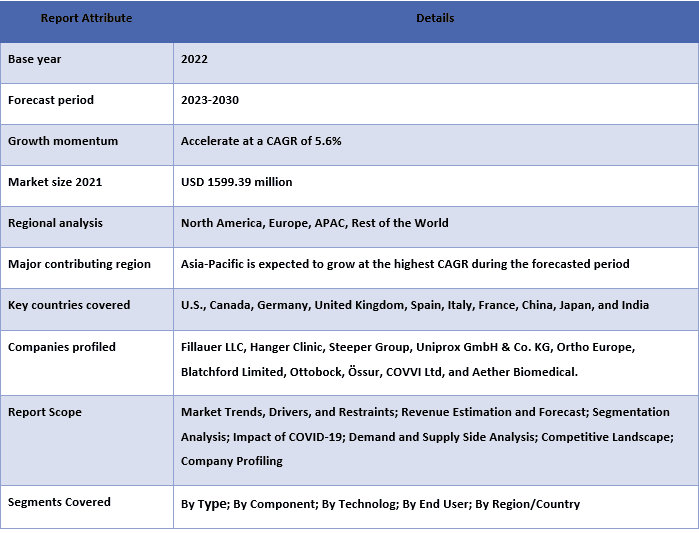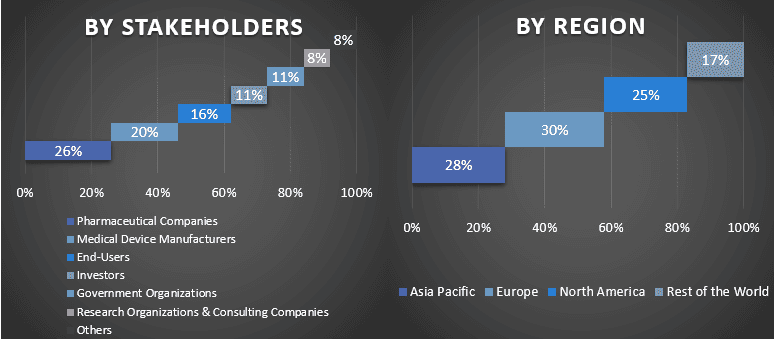- Startseite
- Über uns
- Industrie
- Dienstleistungen
- Lesen
- Kontaktieren Sie uns
Markt für Gliedmaßenprothesen: Aktuelle Analyse und Prognose (2023-2030)
Betonung auf Typ (obere Gliedmaßen und untere Gliedmaßen); Technologie (konventionelle Prothesen, elektrische Prothesen und Hybridprothesen); Komponente (Schaft, Anhang, Gelenk und Sonstige); Endbenutzer (Orthopäden & Prothetiker-Kliniken, orthopädische Kliniken und Sonstige); Region/Land.

Der Markt für Gliedmaßenprothesen wurde auf 1599,39 Millionen USD geschätzt und wird voraussichtlich mit einer starken CAGR von rund 5,6 % im Prognosezeitraum (2023-2030) wachsen, was auf die steigende Prävalenz von Gliedmaßenverlust zurückzuführen ist.
Marktanalyse für Gliedmaßenprothesen
Gliedmaßenverlust kann aus verschiedenen Gründen auftreten, darunter traumatische Unfälle, angeborene Erkrankungen, Gefäßerkrankungen, Krebs und Infektionen. Die zunehmende globale Inzidenz dieser Faktoren hat zu einer höheren Anzahl von Personen geführt, die mit Gliedmaßenverlust leben, wodurch die Nachfrage nach Prothesen gefördert wird.
Es wird geschätzt, dass allein in den USA rund 1,5 Millionen Menschen mit Gliedmaßenverlust leben, so frühere Statistiken der Amputee Coalition, einer nationalen gemeinnützigen Organisation. Die Hauptursachen für Gliedmaßenverlust in den USA sind Gefäßerkrankungen (hauptsächlich im Zusammenhang mit Diabetes und peripherer arterieller Verschlusskrankheit) und Traumata, während Krebs-bedingte Amputationen weniger häufig sind.
Darüber hinaus gibt es nach Angaben der International Society for Prosthetics and Orthotics (ISPO) weltweit schätzungsweise 30 Millionen Menschen, die mit Gliedmaßenverlust leben. Es wird geschätzt, dass etwa 15 Millionen dieser Personen in Entwicklungsländern leben. Der Großteil des Gliedmaßenverlusts tritt bei Personen über 65 Jahren auf, wobei die höchste Inzidenz bei Männern zu verzeichnen ist. Die Hauptursachen für Gliedmaßenverlust sind Traumata, Krebs und Infektionen, wodurch das Wachstum des Marktes im Prognosezeitraum angekurbelt wird.
Markttrends für Gliedmaßenprothesen
In diesem Abschnitt werden die wichtigsten Markttrends erörtert, die die verschiedenen Segmente des Marktes für Gliedmaßenprothesen beeinflussen, wie von unserem Team von Forschungsexperten ermittelt.
Hybridprothesen transformieren die Industrie
Eine Hybridprothese ist eine fortschrittliche und innovative Technologie, die die Vorteile sowohl mechanischer als auch elektronischer Komponenten kombiniert. Sie wurde entwickelt, um die Funktionalität und das Aussehen natürlicher Gliedmaßen nachzubilden und Amputierten mehr Mobilität und Funktionalität zu bieten. Die mechanischen Komponenten des Geräts, wie z. B. Gelenke und Scharniere, ermöglichen einen großen Bewegungsspielraum und Flexibilität. Gleichzeitig verbessern die elektronischen Elemente, wie z. B. Sensoren und Mikroprozessoren, die Steuerung und Präzision des Geräts. Hybridprothesen haben in den letzten Jahren aufgrund mehrerer treibender Faktoren erhebliche Aufmerksamkeit und Popularität erlangt. Erstens hat der Fortschritt der Technologie maßgeblich zur Entwicklung von Hybridprothesen beigetragen. Mit der Implementierung von KI und Robotik sind diese Geräte in der Lage, natürliche Bewegungen nachzuahmen und Amputierten eine verbesserte Funktionalität zu bieten, wodurch ihre Lebensqualität verbessert wird. Eine bedeutende Entwicklung ist die Einführung des „Symbionic Leg 4“ durch Össur, einen führenden isländischen Prothesenhersteller, im Jahr 2022. Dieses Hybridprothesengerät kombiniert die Kraft der Robotik und der fortschrittlichen Biomechanik, um Anwendern in der MENA-Region ein natürlicheres Geherlebnis zu bieten. Die Einführung des Symbionic Leg 4 zeigt das Engagement von Össur für Innovation und die Erfüllung der sich entwickelnden Bedürfnisse von Amputierten in der Region.

Innerhalb Nordamerikas hält die Vereinigten Staaten einen großen Marktanteil. Die wichtigsten Faktoren, die das Wachstum des Marktes in dem Land ankurbeln, sind die zunehmende Anzahl von Sportverletzungen, der wachsende Fokus auf Forschung und Entwicklung, eine gut etablierte Gesundheitsinfrastruktur und die Präsenz mehrerer Marktteilnehmer.
Laut einer Regierungsquelle, den Centers for Disease Control and Prevention (CDC), leben schätzungsweise etwa 2,1 Millionen Menschen in den Vereinigten Staaten mit Gliedmaßenverlust. Diese Statistik unterstreicht die schiere Größe der Bevölkerung, die Gliedmaßenprothesen benötigt, und hebt das potenzielle Marktnachfrage hervor.
Laut der American Orthotics and Prosthetic Association (AOPA) wurde im Juli 2021 der Medicare Orthotics and Prosthetics Patient-centered Care Act im Senat eingebracht, was zu einem Anstieg der Nachfrage nach Prothesen und Orthesen in den USA führte. Im Dezember 2022 schlossen die NYU Langone Krankenhäuser ihre ersten Operationen unter Verwendung von FDA-zugelassenen implantierbaren Prothesen für Personen mit Gliedmaßenverlust ab, eine Behandlung, die auch im weiteren Gebiet von New York City zugänglich ist. Dieses Verfahren, bekannt als Osseointegration, zielt darauf ab, die Lebensqualität von Personen mit Gliedmaßenverlust zu verbessern, indem die Verbindung zwischen der Gliedmaße und der Prothese gestärkt wird.

Branchenüberblick über Gliedmaßenprothesen
Der Markt für Gliedmaßenprothesen ist wettbewerbsorientiert und fragmentiert, mit der Präsenz mehrerer globaler und internationaler Marktteilnehmer. Die wichtigsten Akteure verfolgen verschiedene Wachstumsstrategien, um ihre Marktpräsenz zu verbessern, wie z. B. Partnerschaften, Vereinbarungen, Kooperationen, Produkteinführungen, geografische Expansionen sowie Fusionen und Übernahmen. Einige der wichtigsten Akteure auf dem Markt sind Fillauer LLC, Hanger Clinic, Steeper Group, Uniprox GmbH & Co. KG, Ortho Europe, Blatchford Limited, Ottobock, Össur, COVVI Ltd und Aether Biomedical.
Nachrichten zum Markt für Gliedmaßenprothesen
Im Oktober 2021 gab Ottobock, ein führender Hersteller von Prothesen, die Einführung seines neuen Prothesenfußes namens „Meridium“ auf dem US-Markt bekannt. Der Fuß integriert fortschrittliche Technologie- und Designmerkmale, um die Stabilität, Energieeffizienz und den Gehkomfort für die Benutzer zu verbessern.
Im September 2021 gab Open Bionics, ein in Großbritannien ansässiges Unternehmen, erhebliche Investitionen sowohl von der Regierung der Vereinigten Staaten als auch von der Regierung des Vereinigten Königreichs bekannt, um seine erschwinglichen, fortschrittlichen Prothesenarme auf den US-Markt auszudehnen. Die Investition zielt darauf ab, die Zugänglichkeit und Erschwinglichkeit von Prothesen für die oberen Gliedmaßen für Amputierte zu verbessern.
Marktberichtsumfang für Gliedmaßenprothesen

Gründe für den Kauf dieses Berichts:
- Die Studie beinhaltet Marktabschätzung und Prognoseanalysen, die von authentifizierten Branchenexperten validiert wurden.
- Der Bericht präsentiert einen schnellen Überblick über die Gesamtleistung der Branche auf einen Blick.
- Der Bericht umfasst eine eingehende Analyse prominenter Branchenkollegen mit einem primären Fokus auf wichtige Geschäftsfinanzen, Produktportfolios, Expansionsstrategien und aktuelle Entwicklungen.
- Detaillierte Untersuchung der treibenden Kräfte, Einschränkungen, wichtigsten Trends und Chancen in der Branche.
- Die Studie deckt den Markt umfassend über verschiedene Segmente hinweg ab.
- Detaillierte Analyse des Marktes auf regionaler Ebene.
Anpassungsoptionen:
Der globale Markt für Gliedmaßenprothesen kann weiter an die Anforderungen oder jedes andere Marktsegment angepasst werden. Darüber hinaus versteht UMI, dass Sie möglicherweise Ihre eigenen Geschäftsanforderungen haben, daher können Sie sich gerne mit uns in Verbindung setzen, um einen Bericht zu erhalten, der Ihren Anforderungen voll und ganz entspricht.
Inhaltsverzeichnis
Forschungsmethodik für die Marktanalyse von Gliedmaßenprothesen (2023-2030)
Die Analyse des historischen Marktes, die Schätzung des aktuellen Marktes und die Prognose des zukünftigen Marktes des globalen Marktes für Gliedmaßenprothesen waren die drei Hauptschritte, die unternommen wurden, um die Akzeptanz von Gliedmaßenprothesen in den wichtigsten Regionen weltweit zu erstellen und zu analysieren. Es wurden umfassende Sekundärforschungen durchgeführt, um die historischen Marktzahlen zu sammeln und die aktuelle Marktgröße zu schätzen. Zweitens wurden zur Validierung dieser Erkenntnisse zahlreiche Erkenntnisse und Annahmen berücksichtigt. Darüber hinaus wurden umfassende Primärinterviews mit Branchenexperten entlang der Wertschöpfungskette des globalen Marktes für Gliedmaßenprothesen durchgeführt. Nach der Annahme und Validierung der Marktzahlen durch Primärinterviews haben wir einen Top-Down-/Bottom-Up-Ansatz angewendet, um die gesamte Marktgröße zu prognostizieren. Danach wurden Methoden der Marktaufschlüsselung und Datentriangulation eingesetzt, um die Marktgröße der Segmente und Untersegmente der jeweiligen Branche zu schätzen und zu analysieren. Die detaillierte Methodik wird im Folgenden erläutert:
Analyse der historischen Marktgröße
Schritt 1: Detaillierte Studie von Sekundärquellen:
Es wurde eine detaillierte Sekundärstudie durchgeführt, um die historische Marktgröße des Marktes für Gliedmaßenprothesen über unternehmensinterne Quellen wie Jahresberichte und Finanzberichte, Leistungsvorstellungen, Pressemitteilungen usw. sowie externe Quellen wie Fachzeitschriften, Nachrichten und Artikel, Regierungsveröffentlichungen, Wettbewerberpublikationen, Sektorberichte, Datenbanken von Drittanbietern und andere glaubwürdige Veröffentlichungen zu erhalten.
Schritt 2: Marktsegmentierung:
Nachdem wir die historische Marktgröße des Marktes für Gliedmaßenprothesen ermittelt hatten, führten wir eine detaillierte Sekundäranalyse durch, um historische Markteinblicke und -anteile für verschiedene Segmente und Untersegmente für wichtige Regionen zu sammeln. Zu den wichtigsten Segmenten, die in dem Bericht enthalten sind, gehören Typ, Technologie, Komponente und Endbenutzer. Es wurden weitere Analysen auf Länderebene durchgeführt, um die Gesamtakzeptanz von Testmodellen in dieser Region zu bewerten.
Schritt 3: Faktorenanalyse:
Nachdem wir die historische Marktgröße verschiedener Segmente und Untersegmente ermittelt hatten, führten wir eine detaillierteFaktorenanalysedurch, um die aktuelle Marktgröße des Marktes für Gliedmaßenprothesen zu schätzen. Darüber hinaus führten wir eine Faktorenanalyse unter Verwendung abhängiger und unabhängiger Variablen wie Typ, Technologie, Komponente und Endbenutzer des Marktes für Gliedmaßenprothesen durch. Es wurde eine gründliche Analyse für Nachfrage- und Angebotsseitenszenarien durchgeführt, wobei die wichtigsten Partnerschaften, Fusionen und Übernahmen, Geschäftserweiterungen und Produkteinführungen im Marktsektor für Gliedmaßenprothesen weltweit berücksichtigt wurden.
Schätzung und Prognose der aktuellen Marktgröße
Aktuelle Marktabschätzung:Basierend auf umsetzbaren Erkenntnissen aus den obigen 3 Schritten kamen wir zur aktuellen Marktgröße, den wichtigsten Akteuren auf dem globalen Markt für Gliedmaßenprothesen und den Marktanteilen der Segmente. Alle erforderlichen prozentualen Anteile, Aufteilungen und Marktberechnungen wurden mit dem oben genannten sekundären Ansatz ermittelt und durch Primärinterviews verifiziert.
Schätzung und Prognose:Für die Marktabschätzung und -prognose wurden den verschiedenen Faktoren, einschließlich der Treiber und Trends, Einschränkungen und Chancen, die den Interessengruppen zur Verfügung stehen, Gewichtungen zugewiesen. Nach der Analyse dieser Faktoren wurden relevante Prognosetechniken, d. h. der Top-Down-/Bottom-Up-Ansatz, angewendet, um die Marktprognose für 2030 für verschiedene Segmente und Untersegmente in den wichtigsten Märkten weltweit zu ermitteln. Die Forschungsmethodik zur Schätzung der Marktgröße umfasst:
- Die Marktgröße der Branche, in Bezug auf den Umsatz (USD) und die Adoptionsrate des Markt für Gliedmaßenprothesen in den wichtigsten Märkten im Inland
- Alle prozentualen Anteile, Aufteilungen und Aufschlüsselungen der Marktsegmente und Untersegmente
- Schlüsselakteure im globalen Markt für Gliedmaßenprothesen in Bezug auf die angebotenen Produkte. Außerdem die Wachstumsstrategien, die diese Akteure anwenden, um im schnell wachsenden Markt zu bestehen
Marktgrößen- und -anteilvalidierung
Primärforschung:Tiefgehende Interviews wurden mit den Key Opinion Leaders (KOLs) geführt, einschließlich Führungskräften (CXO/VPs, Vertriebsleiter, Marketingleiter, Betriebsleiter, Regionalleiter, Länderleiter usw.) in allen wichtigen Regionen. Die Ergebnisse der Primärforschung wurden dann zusammengefasst und eine statistische Analyse durchgeführt, um die aufgestellte Hypothese zu belegen. Die Erkenntnisse aus der Primärforschung wurden mit den Sekundärbefunden konsolidiert, wodurch Informationen in umsetzbare Erkenntnisse umgewandelt wurden.
Aufteilung der primären Teilnehmer in verschiedenen Regionen

Markttechnik
Die Daten-Triangulationstechnik wurde eingesetzt, um die gesamte Marktabschätzung abzuschließen und präzise statistische Zahlen für jedes Segment und Untersegment des globalen Marktes für Gliedmaßenprothesen zu erhalten. Die Daten wurden nach der Untersuchung verschiedener Parameter und Trends in den Bereichen Typ, Technologie, Komponente und Endanwender im globalen Markt für Gliedmaßenprothesen in mehrere Segmente und Untersegmente aufgeteilt.
Das Hauptziel der Globalen Marktstudie für Gliedmaßenprothesen
Die aktuellen und zukünftigen Markttrends des globalen Marktes für Gliedmaßenprothesen wurden in der Studie ermittelt. Investoren können strategische Erkenntnisse gewinnen, um ihre Entscheidungen für Investitionen auf der in der Studie durchgeführten qualitativen und quantitativen Analyse zu basieren. Aktuelle und zukünftige Markttrends bestimmten die allgemeine Attraktivität des Marktes auf regionaler Ebene und boten den industriellen Teilnehmern eine Plattform, um den unerschlossenen Markt auszunutzen und von einem First-Mover-Vorteil zu profitieren. Weitere quantitative Ziele der Studien umfassen:
- Analysieren Sie die aktuelle und prognostizierte Marktgröße des Marktes für Gliedmaßenprothesen in Bezug auf den Wert (USD). Analysieren Sie außerdem die aktuelle und prognostizierte Marktgröße verschiedener Segmente und Untersegmente
- Zu den Segmenten in der Studie gehören Bereiche des Typs, der Technologie, der Komponente und des Endanwenders
- Definition und Analyse des regulatorischen Rahmens für die Gliedmaßenprothesenindustrie
- Analyse der Wertschöpfungskette unter Einbeziehung verschiedener Intermediäre sowie Analyse des Kunden- und Wettbewerbsverhaltens der Branche
- Analysieren Sie die aktuelle und prognostizierte Marktgröße des Marktes für Gliedmaßenprothesen für die Hauptregion
- Zu den wichtigsten Ländern der in dem Bericht untersuchten Regionen gehören Asien-Pazifik, Europa, Nordamerika und der Rest der Welt
- Unternehmensprofile des Marktes für Gliedmaßenprothesen und die Wachstumsstrategien, die von den Marktteilnehmern angewendet werden, um in dem schnell wachsenden Markt zu bestehen
- Detaillierte Analyse der Branche auf regionaler Ebene
Häufig gestellte Fragen FAQs
Q1: Wie groß ist die aktuelle Marktgröße und das Wachstumspotenzial des Marktes für Gliedmaßenprothesen?
Q2: Was sind die treibenden Faktoren für das Wachstum des Marktes für Gliedmaßenprothesen?
Q3: Welches Segment hat den größten Anteil am Markt für Gliedmaßenprothesen nach Typ?
Q4: Was sind die neuen Technologien und Trends auf dem Markt für Gliedmaßenprothesen?
Q5: Welche Region wird den Markt für Gliedmaßenprothesen dominieren?
Verwandt Berichte
Kunden, die diesen Artikel gekauft haben, kauften auch










